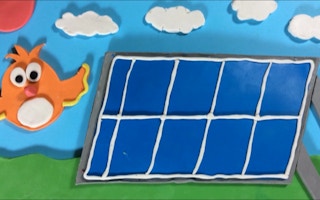An animated short film depicting the use of new climate-friendly technologies in Singapore, a short film where a teenager time-travels from the future to tell his past self to change his wasteful ways, a claymation feature about a boy’s dreams of a greener future – these are some of the award-winning student submissions from this year’s National Climate Change Competition.
Organised by the National Climate Change Secretariat (NCCS), a unit under Strategy Group in the Prime Minister’s Office, the competition challenged students to think about what a climate-friendly Singapore would be like in 2030. The competition received 215 entries from over 70 schools in total.
Guest-of-Honour Deputy Prime Minister Teo Chee Hean, who is also Coordinating Minister for National Security and Chairman of the Inter-Ministerial Committee on Climate Change, gave out prizes to the winning teams at an award ceremony on 4 November 2016.
Taking the first prize in the Institute of Higher Learning category – which was open to Institutes of Technical Education, polytechnics and universities – were students from ITE College East for their animated short. The team’s video shows a green Singapore in 2030 filled with rooftop gardens, accessible public transport options, and factories running on renewable energy.
When asked about his thoughts on how individuals can help make Singapore a climate-friendly place to live in, ITE College East student Ihsan Nursaqif, 20, said that individuals can do their part, for example, by making use of Singapore’s accessible public transport network to get around, instead of driving. Teammate Muhammad Afiq, 20, said that he would make use of the park connectors if he could cycle to school.
“
Though climate change is this far along, even if our country is small, we can contribute in our own ways to reduce the world’s greenhouse gas emissions.
Thania Del R Lofranco, student, Juying Primary School
In the Secondary Schools and Junior Colleges category, an all-boys team from Maris Stella High School took first prize for their video “A Gift from the Future to the Past”, in which the protagonist’s future self travels back in time to urge more climate action so as to build a greener future Singapore.
Secondary 2 student, Chin How Min, 14, said that their entry was conceptualised as a sequel to the school’s video entry in last year’s competition, which also clinched top prize.
Talking about his own eco-actions, team member Louis Ng Ming Gin said he turns the water faucet off when lathering in the shower to save water and energy. The 14-year-old added that: “When I am watching television, I avoid having other appliances switched on if I don’t need them, as they consume a lot of electricity.”
Meanwhile, Leanne Choo from CHIJ St Nicholas Girls’ School bagged a merit award and Viewer’s Choice for her video “Change for the Better”. The 16-year-old animation aficionado said she had a change of perspective as she did her research for the video.
“Initially, I felt that climate change didn’t really matter to me,” she said. “But now that I have taken part in this competition, I have learned about ways to conserve energy and realise the urgent need to reduce our carbon emissions, because we do not have a lot of time left.”
At home, Choo is careful about her use of water and electricity. “People brush their teeth and rinse with running water, but I usually use a cup,” she said.
A claymation by a five-student team from Juying Primary School clinched the top prize in the Primary Schools category, the second time in a row for the school. In it, a boy dreams of Singapore in 2030, where citizens recycle, grow their own food, and use solar-powered home appliances.
Explaining the motivation behind joining the competition, Thania Del R Lofranco, 12, said: “Though climate change is this far along, even if our country is small, we can contribute in our own ways to reduce the world’s greenhouse gas emissions.”
When asked what were some of the measures the team takes to be more environmentally friendly, 10-year old Chua Ming Geok said: “We switch off electrical appliances when not in use and choose to buy energy-saving electrical appliances.”
In Deputy Prime Minister Teo’s speech at the ceremony, he said that even though Singapore only accounts for 0.12 per cent of global emissions, the nation must do its part against climate change, and called on the students to be active ambassadors.
“You have taken the first step to help spread the message – keep our energy consumption low in our schools, homes, offices, and factories. Be ready, and work with your teachers and principals to reduce electricity usage in school, and with your friends and parents to do so at home,” he said.
He continued: “Many of you would have got married and started your families by 2030. As we develop Singapore into a climate-friendly city, your choices today will have an impact on our future generations.”
Check out the students’ winning videos on NCCS YouTube channel at www.youtube.com/nccssg.
Subscribe here or like our Facebook page to receive regular updates on new articles.

















